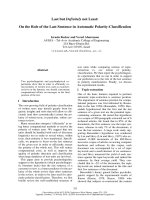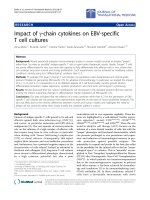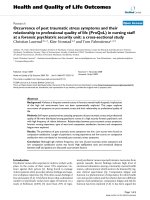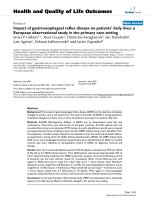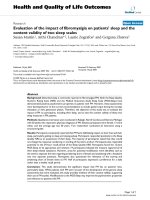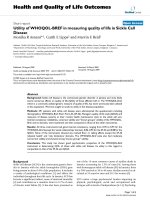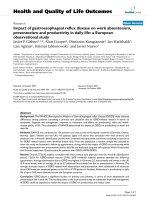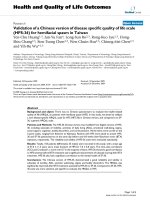báo cáo hóa học:" Impact of recent life events on the health related quality of life of adolescents and youths: the role of gender and life events typologies in a follow-up study" potx
Bạn đang xem bản rút gọn của tài liệu. Xem và tải ngay bản đầy đủ của tài liệu tại đây (241.65 KB, 9 trang )
RESEARC H Open Access
Impact of recent life events on the health
related quality of life of adolescents and youths:
the role of gender and life events typologies in a
follow-up study
Ester Villalonga-Olives
1,2
, Sonia Rojas-Farreras
2
, Gemma Vilagut
1,2
, Jorge A Palacio-Vieira
3
, José Maria Valderas
1,2,4
,
Michael Herdman
1,2
, Montserrat Ferrer
1,2,5
, Luís Rajmil
1,2,3
, Jordi Alonso
1,2,6*
Abstract
Background: Most studies on the effect of life events (LEs) have been carried out in convenience samples which
cannot be considered representative of the general population. In addition, recent studies have observed that
gender differences in the health related quality of life (HRQoL) impact of LEs might be lower than believed. We
assessed the relationship between LEs and HRQoL in a representative sample of Spanish adolescents/youths,
focusing on gender differences.
Methods: Participants (n = 840) completed the KIDSCREEN-27 to measure HRQoL at baseline and again after
3 years (n = 454). Follow-up assessment included the Coddington Life Events Scales (CLES) to measure LEs
experiences in the previ ous 12 months. Respondents were categorized according to the amount of stress suffered.
We calculated both the number of LEs and the Life Change Unit (LCU) score, a summary of the amount of stress
inherent to the event and the time elapsed since occurrence. LEs were classified as desirable or undesirable, and
family-related or extra-family. Effect sizes were calculated to evaluate changes in HRQoL. To assess the impact of
LEs typologies, multiple linear regression models were constructed to evaluate their effect on HRQoL.
Results: Girls reported a mean 5.7 LEs corresponding to 141 LCUs, and boys 5.3 and 129, respectively. The largest
impact of LEs on HRQoL was observed in the group of boys that reported to have lived more stress (third tertil of
LCUs distribution). The linear association between LEs and HRQoL tended to be stronger among boys than girls,
but the difference was not statistically significant. The effect on HRQoL was deemed important when undesirable
events had been experienced. To have an important impact on HRQoL, 200 LCUs due to undesirable events were
necessary in boys. In girls, slightly higher scores were necessary for a similar impact.
Conclusions: A moderate association was found between recent LEs and HRQoL, mainly among those who
experienced several undesirable events that correspond to at least 200 LCUs. No gender differ ences were found in
this association. Results may be useful for identifying adolescents with particular health risks, regardless of gender.
Background
Adolescence and youth are considered periods of devel-
opment when individuals construct their own identity
[1]. These periods include life events (LEs) and transi-
tions[2], which can be either desirable or undesirable.
LEs can be stressors and demand a special readjustment
to reorganise daily life and they might inf luence child’s
development[3-5]. Frequent exposure to LEs during
adolescence and youth has been shown to be associated
with worse health related quality of life (HRQoL)[6-9],
psychosomatic complaints[10-12], poor physical func-
tioning, higher risk of disabilities, and greater use of
health services[13].
Most studies on the effect of LEs have been carried
out in convenience samples which cannot be considered
representative of the gener al population[14-16], limiting
* Correspondence:
1
CIBER en Epidemiología y Salud Pública (CIBERESP), Spain
Villalonga-Olives et al. Health and Quality of Life Outcomes 2010, 8:71
/>© 2010 Villal onga- Olives et al; licensee BioMed Central L td. T his is an Open Access article d istribu ted under the t erms of the Creative
Commons Attribution License ( which permits unrestricted use, distribution, and
reproductio n in any medium , provided the original work is properly cited.
their ability to make inferences based on the available
observations. Studies based on general population are
deemed needed[13,17], to establish whether gender-
based differences exist in such samples. Importantly, the
associations between LEs and health related outcomes
have been generally assessed in cross-sectional design
studies[14-16,18].Thisdesigndoesnotallowtaking
into acc ount health status previous to the LEs suffered,
resulting in possible biases. For instance, girls usually
report low levels of HRQoL. Lacking a previous measure
of perceived health m ay lead to over estim ate the effect
of LEs experiences on girls.
Gender differences in exposure and reactions to LEs
have been widely discussed[14,15,19,20] and seem to
have an effect onto mental health an d functional out-
comes stronger among girls than boys [15,19,21-23]. But
more recent studies have failed to observe gender differ-
ences or fewe r negative associations. The latter results
have reported change s in the traditional gen der differ-
ences of coping with LEs, might be explained by modifi-
cations in social resources, and gender role expectations
[2,24-26]. This “buffering hypothesis” would predict a
significant interaction effect for soc ial support and life
events in relation to psychological outcome, which
seems to be the case of gi rls, which perceive higher
levels of social support in recent studies[2]. In addition,
although it is known that exposure to LEs can have
health consequences, we are not sure about which ones
(desirable or undesirable events, or other categories as
family or extrafamily) are most influencing[3,4,27].
The aim of the present study was to investigate t he
impact of LEs on HRQoL using data collected with a
longitudinal design, in a general population sample.
Additionally, we investigated whether there were gen-
der-based differences in the association between LEs
and HRQoL [28]; and whether desirable and undesirable
events and t hose which occurred within the family con-
text versus extra-fami ly impacted differently on HRQoL.
We had anticipated that no gender differences in the
association between LEs and HRQoL would be found,
and that undesirable events and those related to family
life would be more strongly associated with HRQoL
[3,4,27].
Methods
Sample and data collection
The Spanish KIDSCREEN baseline sample was recruited
between May and November 2003 as part of the Eur-
opean KIDSCREEN fieldwork [29]. The target popula-
tion for the KIDSCREEN study was children and
adolescents aged 8-18. The aim was to recruit a sample
that was representative by gender and age in each parti-
cipating country a ccording to census data. Telephone
sampling was performed centrally from Germany, and
was carried out using a Computer Assisted Telephone
Interview with random-digital-dialli ng. Households were
contacted by telephone and asked to participate by
interviewers who had received study-speci fic training. If
the family member contacted agreed to participate, the
questionnaire and other study materials were mailed to
the requisite address together with a stamped, addressed
envelope and informe d consent for return of the com-
pleted questionnaire. A telephone hotline was used to
provide further information about the survey. Two
reminders were sent in cases of non-response (after two
and five weeks). More details are provided elsewhere
[28,29].
Between May and November 2006, follow-up ques-
tionnaires were posted by mail to all adolescents and
youths and their parents who had previously agreed to
participate in the Spanish KIDSCREEN follow-up study
(n = 840 of 926 participants at baseline; 91%). Data col-
lection at follow-up took place 3 years after baseline, a
period which was considered a sufficient interval to
allow for substantive change s in participants’ health sta-
tus. The fieldwork followed the same methodology
applied at baseline. Postal remind ers were sent four and
eight weeks after the first mailing to those who had not
returned their completed questionnaires. A third remin-
der was sent after twenty weeks and any remaining non-
respondents were contacted by phone.
Measures
Life events
Stressful LEs were measured using the Coddington Life
Events Scales (CLES)[3,4, 27], whi ch measure the occur-
rence of 53 LEs. Respondents indicate for each item
describing a specific LE and the n umber of times the
event has occurred in the last 3 months, 4-6 months
earlier, 7-9 months earlier, or 10-12 months earlier. The
frequency of occurrence is taken into account in the cal-
culation of Life Change Units (LCUs) which also reflect
the amount of stress inherent to the event and how
long ago it happened. We used the original LCUs,
which were obtained from ratings provided by teachers,
paediatricians, and child psychiatrists[3,4,27]. A total
LCU score can be calculated for each respondent as a
weighted sum of all the LCU scores (range of LCUs for
one LE: 5-216). We used the Spanish version of CLES
that has been found to be valid and psychometrical ly
equivalent to the original [30].
Life events were classified according to two different
typologies : desirable (e.g. “Graduating from high schoo l)
vs. undesirable events (e.g. “ Divorce of parents) and
family-related (e.g. “ Loss of a job of your father or
mother”) vs. extra-family events (e.g. “Going on the first
date” ) [3-5,27,31]. Each LE was classified accordingly
into one of the tw o categories in eac h typology, except
Villalonga-Olives et al. Health and Quality of Life Outcomes 2010, 8:71
/>Page 2 of 9
nine which were classified in only one LE typology (e.g.
“Being hospitalized for illness or injury” was undesirable
but was not classified in the ‘family’ typology because it
was neutral with regard to that particular typology).
Health Related Quality of Life
HRQoL was measured using the KIDSCREEN-27[32],
which was administered at baseline and follow-up to
the adolescents and youths (self-reported) and to their
parents (proxy-reported) with a recall period of 1
week. The KIDSCREEN-27 has 5 dimensions: Physical
Well-being (PH, 5 items); P sychological Well-being
(PW, 7 items); Parent Relation & Home Life (PA, 7
items); Social Support & Peers (PE, 4 items) and
School Environment (SC, 4 items). We also calculated
an overall index score (KIDSCREEN-10) based on
selected items[32].
The KIDSCREEN items use 5-point Likert-type scales
to assess either frequency (never-seldom-sometimes-
often-always) or intensity (not at all-slightly-moderately-
very-extremely). Rasch scores are computed for each
dimension and for the overall score and are transformed
into T-values with a mean of 50 and standard dev iation
(SD) of 10. The T scores refer to the mean values and
SD from a representative sample of the European gen-
eral population so that scores over (or under) 50 indi-
cate better (or worse) HRQoL than the general EU
population. The Spanish version of the questionnaire
has demonstrated acceptable validity and reliability
[33,34]. In this study, only responses from adolescents
and youths on the KIDSCREEN questionnaire were
used.
Pubertal development
Pubertal development was measured in order to adjust
for possible differences between boys and girls in terms
of pubertal status[1] and because of its dem onstrated
relationship with HRQoL[35]. We used the Pubertal
Development S cale (PDS), a self-reported measure with
acceptable levels of validity [36], which assesses pubertal
characteristics. Subjects respond to each item on a 4-
point ordinal scale (no development = 1, development
barely begun = 2, development definitely underway = 3,
and development already completed = 4). An extra
response category was i ncluded in each item of the PDS
to determine whether development had been completed
before the baseline assessment. The menarche item was
scored 1 if the girl was pre-menarche and 4 if menstrual
periods had already begun. Item scores were summed to
produce an overall continuous scor e ranging fro m 5 to
25. Higher scores reflect a greater degree of pubertal
development. Pubertal development was only measured
at follow-up.
Sociodemographic variables
Other variables collected in the present study to charac-
terize the sample were family socio-economic status and
parental level of education. Socio-economic status was
measured using the Family Affluence Scale[37], which
includes questions on family car ownership, having own
unshared room, the number of computers at home, and
how many times the family went on holiday in the pre-
vious 12 months. FAS scores were categorized as low
(1), intermediate (2), and high (3) affluence level. Paren-
tal level of education was collected from the adult
respondent and included the highest family level of edu-
cation according to the International Standard Classifi-
cation of Education (ISCED). Categories were: low (a
maximum of lower secondary level, ISCED 0-2), med-
ium (upper secondary level, ISCED 3-4), and high (uni-
versity degree, ISCED 5-6)[38].
Statistical analysis
Differences between boys and girls in relation to LEs
and HRQoL were tested using independent two-sample
t-tests for continuous variables and chi-square tests f or
categorical variables. P-values were adjusted with the
Hochberg method in order to address the multiple
testing problem. The decision rule is to reject the
null hypothesis when the adjusted p-value is les s than
a = 0.05[39].
To investigate the first aim of the study, bivariate ana-
lyses of the effects of LEs on HRQoL dimensions for
boys and girls were performed. We calculated the effect
sizes of changes in HRQoL (difference between follow-
up and baseline scores divided by baseline standard
deviation) in three different groups of increasing LEs
impact. The three categories were defined based on ter-
tiles of LCU distribution (i.e. 0-67 LCU (low), 68-160
LCU (medium), and 161 LCU or more (high)). Two way
ANOVA was used to determine whether gender differ-
ences were statistically significant.
Multiple linear regression[40] models were tested to
investigate the second aim of the study of whether LEs
typologies impacted differently on HRQoL. The depen-
dent variables were KIDSCREEN dimensions and overall
scores at follow-up; independent variables were the LCU
scores of global LEs and typologies. A c
2
test to assess
non-linearity between LCUs and HRQoL was not signif-
icant, and LCUs were therefore introduced as a linear
variable in the model. Models were fitted to estimate
the relationship between LEs and HRQoL controlling by
baseline HRQoL, pubertal development, and age and
stratified by gender. P-values were adjusted with the
Hochberg method in order to account for the analysis
of multiple end-points. We tested gender differences in
the association between LEs on HRQoL by running
similar models where the gender and the interaction
between gender and LCU s cores were included and
evaluating the significance of the interaction effect with
a two-sided significance test at a = 0.05.
Villalonga-Olives et al. Health and Quality of Life Outcomes 2010, 8:71
/>Page 3 of 9
Coefficients in the multiple linear regression indicate
the units of change in the dependent variable which is
ass ociated with 1 LCU suffered by respondents. To give
more interpretable results, we selected four examples to
illustrate the magnitude of the effect of the coefficients.
To do so, the regression coefficients were multiplied by
different LCUs values that correspond to selected
amounts of LCUs (i.e. 113 LCU, 165 LCU, 235 LCU and
281 LCU) to assess the direct effect on KIDSCREEN. In
addition, to determine minimally important differences
and moderate important differences between respon-
dents (LCUs necessary to have a change in HRQoL of
0.2 and 0.5 SD, respectively)[41]. This transformation
was applied only to un desirable events due to their spe-
cial impact.
We did not attempt to evaluate age groups differences
due to insufficient sample size after distribut ing partici-
pants by LE typology and gender.
Results and Discussion
At follow-up, 454 families were re-assessed (response
rate: 54%). A total of 423 adolescents/youths with com-
plete data were included in the analysis. Mean age was
15.4 (SD 2.84) years and 51.8% were girls (Table 1).
When compared with non-respondents at follow-up,
respondents were younger with a slightly higher parental
level of education. KIDSCREEN scores at follow up were
lower (poorer HRQoL) than at baseline for all dimen-
sions. Girls reporte d significantly lower scores than boys
(p < 0. 05) in t he Physical Well-being dimension both at
baseline and at follow-up.
Boys reported a mean of 5.3 LEs in the previous 12
months compared to 5.7 for girls (P = 0.98) (Table 2).
Desirable events (a mean of 3.1 among boys and of 3.5
among girls) were more common than undesirable
events (2.0 and 2.1), respectively. Extra-family events
(4.4 in boys and 4.7 in girls) were more common than
family events (0.9 in both boys and girls). The mean of
Life Change Units was 127.2 (SE 8.15) for boys and
139.2 (SE 8.04) for girls (P = 0.88). Girls tended to have
higher LCU scores in all LEs categories, though differ-
ences in scores were not statistically significant.
Table 3 shows KIDSCREEN scores at baseline and fol-
low-up and effect sizes for each of the three LEs cate-
gories (tertiles). In general, HRQoL deteriorated over
time in all KIDSCREEN dimensio ns for both boys and
girls. However, in the group of boys that reported the
fewest LEs the decrease was small, with effect size s
Table 1 Sociodemographic and HRQoL characteristics of the study sample.
Baseline (2003) Follow-up (2006)
Boys N = 204 Girls N = 219 Boys N = 204 Girls N = 219
Mean [%] (SD) Mean [%](SD) P-value
*
Mean [%] (SD) Mean [%] (SD) P-value
Sociodemographics Age 12.1 (2.82) 12.7 (2.86) 0.46 15.1 (2.82) 15.7 (2.86) 0.41
Pubertal
Development**
NA NA 15.3 (5.33) 18 (4.48) <0.001
Parental level of
education
Low [50.5%] (50) [48.6%] (50) 0.93 [39.1%] (18.8) [40.0%] (49) 0.98
Medium [25.5%] (43.6) [20.7%] (40.6) [34.4%] (47.5) [28.3%] (45)
High [24%] (42.7) [30.7%] (46.1) [26.5%] (44.1) [31.7%] (46.5)
Socioeconomic level
Low [21.5%] (41.1) [16.8%] (37.4) [13.7%] (34.4) [16.1%] (36.8) 0.98
Medium [47.5%] (49.9) [52.3%] (49.9) 0.93 [54.8%] (49.8) [52.1%] (50)
High [31%] (46.2) [30.8%] (46.2) [31.5%] (46.4) [31.8%] (46.6)
Health Related Quality of
Life (KIDSCREEN)
Overall score (KS-10) 54.5 (10.7) 52.9 (11.9) 0.93 50.5 (8.58) 49.4 (9.42) 0.89
Physical Well-being 54.2 (10.3) 50.4 (11.5) 0.005 50.7 (9.39) 46.6 (10.3) < 0.001
Psychological Well-
being
54.8 (10.3) 52 (11.2) 0.07 51.5 (9.02) 49.9 (9.76) 0.41
School Environment 53 (10.7) 53.5 (10.7) 0.93 50.1 (10.1) 51.8 (8.97) 0.41
Parent Relation &
Home Life
53.2 (9.03) 53.1 (10.7) 0.93 51.5 (8.80) 51.5 (9.16) 0.98
Social support and
Peers
53.5 (8.90) 53.9 (9.17) 0.93 49.3 (8.27) 52.1 (9.06) 0.06
The Spanish KIDSCREEN follow-up study
* Comparison between boys and girls using t-test for continuous variables or c
2
test for categorical variables. P-values adjusted for multiple testing with the
Hochberg method
** Pubertal Development was not available at baseline
Villalonga-Olives et al. Health and Quality of Life Outcomes 2010, 8:71
/>Page 4 of 9
lower than 0.15 for most KIDSCREEN scales. The
exceptions were Social support and peers (ES = -0.41)
and the Overall score (ES = -0.26). Boys with more than
161 LCUs showed a decline on all KIDSCREEN-27
dimensions (ES from -0.4 to -0.55), except for Parent
relation and home life (ES = -0.25). In girls, the pattern
was different because the ES observed in each of the
KIDSCREEN-27 dimensions were similar across the
three LCU groups and under 0.40 in all cases. Gender
differences regarding the change in K IDSCREEN scores
were not statistically significant, except for the Social
Support and Peers dimension.
Multiple linear regression analysis indicated that LEs
tended to affect more HRQoL dimensions in boys than
in girls, though gender differences were not statistically
significant (Table 4). After Hochberg adjustment for
multiple comparisons, the strongest associations were
seen between undesirable even ts and HRQoL on the
Psychological Well-being and School Environment
dimensions and the Overall score in boys, and on the
School Environment and Physical Well-b eing dimen-
sions in girls. In the case of desirable, family and extra-
family events, none of the coefficients were sta tistically
significant.
Table 2 Life events (previous 12 months) reported by the study sample.
Type of life events Number of life events (in the last 12 months) Life Change Units
Boys (N = 204) Girls (N = 219) Boys (N = 204) Girls (N = 219)
Mean (SE) Mean (SE) P value* Mean (SE) Mean (SE) P value*
Overall 5.33 (0.35) 5.68 (0.37) 0.98 127.2 (8.15) 139.2 (8.04) 0.88
Desirable 3.12 (0.22) 3.46 (0.23) 0.98 65.86 (4.42) 75.92 (4.86) 0.64
Undesirable 1.97 (0.20) 2.05 (0.20) 0.98 55.10 (5.02) 59.37 (4.78) 0.92
Family 0.91 (0.11) 0.9 (0.09) 0.98 28.46 (3.82) 28.93 (3.20) 0.92
Extrafamily 4.37 (0.32) 4.74 (0.35) 0.98 97.95 (6.86) 108.9 (6.84) 0.88
The Spanish KIDSCREEN follow-up study
* Two-sided t-test for independent samples at p = 0.05 significance level. P-values adjusted for multiple testing with the Hochberg method
Table 3 KIDSCREEN mean scores and standardized effect sizes between baseline and follow-up, by level of LCUs
experienced
LEs experiences in the previous 12 months (tertiles) KS-10 Physical
well-being
Psychological
well-being
School
Environment
Parent
relation and
Home Life
Social
Support
and Peers
Boys Girls Boys Girls Boys Girls Boys Girls Boys Girls Boys Girls
Low: 0-67 LCUs (33.3%)
Baseline 55.3 55.4 52.5 51.7 54.8 54 54.8 55.6 54.1 55.5 53.6 55.2
Follow-up 52.3 51.7 51.9 47.9 54 52.1 53.7 52.7 52.7 53.7 49.7 52.2
Effect Size -0.26 -0.37 -0.06 -0.39 -0.07 -0.19 -0.09 -0.28 -0.13 -0.17 -0.41 -0.31
Medium: 68-160 LCUs (33.3%)
Baseline 56.5 51.3 56.3 50.6 55.8 51.6 54.1 52.1 53.9 52.2 53.6 53.9
Follow-up 51.4 48.9 51.4 46 51.4 48.9 50.1 52.4 52.4 51.1 49.7 51.1
Effect Size -0.48 -0.19 -0.47 -0.38 -0.4 -0.22 -0.36 0.03 -0.18 -0.1 -0.46 -0.37
High: +161 LCUs (33.3%)
Baseline 51.5 52 53.9 48.8 53.7 50.4 49.6 52.7 51.3 51.5 53 52.7
Follow-up 47.6 47.7 48.6 45.9 48.8 48.7 46.2 50.4 49.2 49.8 48.2 53
Effect Size -0.44 -0.33 -0.52 -0.23 -0.51 -0.16 -0.4 -0.22 -0.25 -0.16 -0.55 0.03
Overall LCUs (100%)
Baseline 54.5 52.9 54.25 50.39 54.81 52.02 52.97 53.45 53.16 53.07 53.47 53.93
Follow-up 50.51 49.41 50.73 46.62 51.48 49.87 50.12 51.38 51.5 51.52 49.26 52.13
Effect Size -0.37 -0.29 -0.34 -0.33 -0.32 -0.19 -0.27 -0.15 -0.18 -0.14 -0.47 -0.2
ANOVA* F (P-value) F (P-value) F (P-value) F (P-value) F (P-value) F (P-value)
Gender (1 df) 0.17 (0.68) 0.39 (0.53) 1.84 (0.18) 0.94 (0.33) 0.05 (0.82) 7.12 (0.01)
LCUs (2df) 0.35 (0.70) 2.07 (0.13) 1.70 (0.18) 0.44 (0.65) 0.34 (0.71) 0.54 (0.58)
Interaction gender & LCUs (2df) 0.39 (0.68) 1.32 (0.27) 1.28 (0.28) 2.47 (0.09) 0.11 (0.89) 2.09 (0.13)
*Two way ANOVA
Villalonga-Olives et al. Health and Quality of Life Outcomes 2010, 8:71
/>Page 5 of 9
The impact on HRQoL of an increasing amount of
LCUs stemming from undesirable events is presented in
Table5.Dataillustratethemagnitudeoftheeffect
when several LEs combinations are lived. Two undesir-
able LEs lived by 16.3% of respondents involve a
decrease of 2.72 and 2.14 in KIDSCREEN scores in boys
and girls, respectively. While one more undesirable LE
is lived, the impact increases considerably. To calculate
the minimally important difference (MID) on the
KIDSCREEN we calculated the LCUs necessary to have
a difference of 0. 2 SD, and a moderate important differ-
ence established at 0.5 SD. In the case of undesirable
LEs the MID of 0.2 is achieved when at least 75 LCUs
are lived in boys [weighted life event units 75*(-0 .024))/
8.58]. A score of 200 LCUs stemming from undesirable
events (200*[-0.024]/8.58) would be associated with a
decrease of 4 .8 points in overall H RQoL in boys which
involves a decrement of 0.55 SD in the KIDSCREEN.
Thisvaluecorrespondstoamoderateimportantdiffer-
ence to detect respondents more in risk of health conse-
quences, as reported by previous studies [41] which is
the 6.5% of the study sample. In this case, the effects
were slightly higher in boys despite differences were not
statistically significant, though girls should experience a
higher amount of LCUs to have the same effect.
In this representative sample of the general youth
population of Spain, we observed a negative association
between LEs and HRQoL, especiall y on Physical Well-
being, Psychological Well-being and School Environ-
ment, but also on Overall H RQoL. The decrements in
Table 4 Multivariate analysis of the association of LEs and HRQoL, by life event typologies.
Type of life
events
KS-10 Physical well-being Psychological well-
being
School
Environment
Parent relation
and Home Life
Social Support
and Peers
Boys Girls Boys Girls Boys Girls Boys Girls Boys Girls Boys Girls
All -0.013
(0.005)
-0.006
(0.004)
-0.014
(0.005)
-0.004
(0.005)
-0.015*
(0.005)
-0.001
(0.005)
-0.016*
(0.005)
-0.007
(0.005)
-0.012
(0.005)
-0.007
(0.005)
-0.004
(0.005)
0.011
(0.005)
Desirable 0.000
(0.010)
0.008
(0.008)
-0.013
(0.011)
0.017
(0.008)
0.002
(0.010)
0.005
(0.008)
-0.002
(0.010)
0.011
(0.008)
-0.002
(0.010)
0.007
(0.008)
0.004
(0.010)
0.011
(0.008)
Undesirable -0.024*
(0.008)
-0.019
(0.008)
-0.017
(0.009)
-0.025*
(0.009)
-0.029*
(0.008)
-0.004
(0.008)
-0.031*
(0.009)
-0.024*
(0.008)
-0.022
(0.009)
-0.02
(0.008)
-0.009
(0.008)
0.013
(0.008)
Family -0.026
(0.010)
-0.016
(0.011)
-0.014
(0.011)
-0.011
(0.012)
-0.029
(0.010)
-0.013
(0.012)
-0.028
(0.010)
-0.011
(0.011)
-0.02
(0.011)
-0.028
(0.011)
-0.02
(0.010)
0.002
(0.012)
Extrafamily -0.007
(0.006)
-0.003
(0.005)
-0.014
(0.007)
-0.002
(0.006)
-0.008
(0.006)
0.002
(0.006)
-0.012
(0.006)
-0.006
(0.005)
-0.009
(0.006)
-0.002
(0.005)
0.003
(0.006)
0.015
(0.006)
Regression coefficients (SE).
* Statistically significant at p < 0.05. P-values adjusted for multiple testing with the Hochberg method.
** KIDSCREEN overall score and dimension scores adjusted for baseline HRQoL, pubertal development, and age.
Table 5 Estimation of the impact of undesirable events on health related quality of life (KIDSCREEN-10 score)
Total LCUs of
undesirable events
(previous 12 months)
%of
participants
Adjusted estimate (SD)
effect on overall
HRQoL*
Mean change
on KS-10
Overall score
Example of LEs combination
Boys Girls P-value* Boys Girls
113 16.3% -0.024
(0.008)
-0.019
(0.008)
0.33 -2.72 -2.14 Breaking up with a boyfriend/girlfriend (39
LCUs)
Failing a grade in school (74 LCUs)
165 9% -0.024
(0.008)
-0.019
(0.008)
0.33 -3.96 -3.13 Breaking up with a boyfriend/girlfriend (39
LCUs)
Failing a grade in school (74 LCUs)
Hospitalization of a parent (52 LCUs)
235 4.3% -0.024
(0.008)
-0.019
(0.008)
0.33 -5.64 -4.46 Breaking up with a boyfriend/girlfriend (39
LCUs)
Failing a grade in school (74 LCUs)
Hospitalization of a parent (52 LCUs)
Divorce of your parents (70 LCUs)
281 2.9% -0.024
(0.008)
-0.019
(0.008)
0.33 -6.74 -5.33 Breaking up with a boyfriend/girlfriend (39
LCUs)
Failing a grade in school (74 LCUs)
Hospitalization of a parent (52 LCUs)
Divorce of your parents (70 LCUs)
Loss of a job by your father or mother (46
LCUs)
* P-value comparing coefficients among boys and girls
Villalonga-Olives et al. Health and Quality of Life Outcomes 2010, 8:71
/>Page 6 of 9
HRQoL associated with a higher number of LCUs
tended to be greater among boys, though no statistically
significant differences were observed between genders.
Whereas undesirable events were associated with decre-
ments in HRQoL, desirable events and family and extra-
family events were not associated with a corresponding
increase or decrease in HRQoL. In particular, the exis-
tence of a combination of undesirable events summing
to at least 2 00 LCUs was associated with a sizeable
decline in HRQoL (SD 0.5). Our results do confirm the
importance of undesirable LEs in HRQoL and suggest
that it is not differential bygender,whichputforward
the importance of a longitudinal design of the study and
changes in the traditional gender differences.
These results should be interpreted taking into
account several study limitations. First, the response rate
at follow-up was 54%. This figure is quite standard for
postal surveys [19,42-44] and, importantly, the sample
was shown to be representative of the Spanish popula-
tion in terms of age and gender wh en compared to cen-
sus data[28]. A second limitation may arise from the
fact that the CLES use an extensive recall period.
Although it is conceivable that there may operate a
recall bias, we tested the in strument and the recall peri-
ods in a pilot study that showed that they were feasible
and acceptable to respondents[28]. Thirdly, data on
important mediators such as personality and coping
styles was not collected and the association described
here could be confounded by a n umber of unmeas ured
variables. In addition, such confounders could act differ-
ently among the different age groups and their inclusion
could modify the results. Thus, they should be consid-
ered in future studies. Finally, sample size was limited to
test age differences. We performed an analysis stratified
by age and it showed differences in life events experi-
ences and LCUs scores among males (worse for the
older group) but not among females. Also, worse scores
in the KIDSCREEN dimensions were observed in older
ages, especially in Physical Well-being, School Environ-
ment and the KIDSCREEN 10 in females and males.
Stratified data analyses are not presented, but are avail-
able upon request.
Our study has several strengths. Findings regarding
the effect of LEs on HRQoL have almost always been
presented from clinical samples [16,45,46], and the pre-
sent work is one of the few to study the association in a
general population sample. Contrary to previous cross-
sectional design studies [2,14,47,48], a longitudinal
design makes it possible to assess the association
between occurrence of LEs and change in HRQoL[14].
In addition, the present work complements a previous
manuscript that studies the effect of changes in mental
health on HRQoL[49]. There has also been relatively lit-
tle research into the effects of intra-family and desirable
LEs on HRQoL, with most studies focussing on relation-
ships outside of the family, which was previously sug-
gested by T.M. Damush et al[14]. However, we didn’ t
find any difference between intra-family and extra-family
events. Despite these results, when the Hochberg
method for multiple testing is not applied, as authors
like K. Rothman suggest[50], not only undesirab le LEs
are statistically significant, also family events. Despite of
the different recommendations found at the literature,
we considered to include Hochberg corrections to have
more precise results.
There were HRQoL decreases at follow-up in both
gender groups. Girls had lower scores at follow-up[35],
but the assessment of the impact of LEs on HRQoL
showed no gender differences. These results suggest
important differences wit h previous literature
[15,19,21-23]. Previous studies suggested that the bur-
den of demands and limitations on girls was greater due
to their role in society which in turn may have made
them more vulnerable when adversities are experienced
[47]. Previous reports [51,52] found no evidence of dif-
ferential item functioning (DIF) by ge nder in the overall
KIDSCREEN sample. Thus, gender differences described
here must be attributed to real outcome differences
rather than biases due to DIF. On the other hand, stu-
dies that found less gender differences pointed out that
girls may have more sources of support upon than boys
than before[25] and experience social reinforcement by
turning to friends when they have a problem. Whereas
males may experience criticism for not dealing with pro-
blems independently[26]. Our observation of higher
scores on the social support and peers dimension
among girls, although not statistical ly significa nt, would
support this hypothesis.
The differences we ha d hypothesized about the eff ect
of the different LEs based on typologies were only par-
tially confirmed. Undesirable events had the most
important effect on HRQoL, but contrary to our
hypothesis, family events did not affect any of the
dimensions, when Hochberg method for multiple testing
was applied. Our results are consistent with the litera-
ture [53] suggesting the effect of LEs derive primarily
from their undesirability. In other words, the negative
impact on HRQoL of an undesirable LE with a weight
of 50 LCUs will be greater than the corresponding posi-
tive effect on HRQoL of having a desirable event with
the same weight. However, it is important to note that
the association of LEs with HRQoL is moderate and
their effect is considerable when several important LEs
are lived. In our sample, 16.3% of respondents have a
LCU sum score that involves a minimal important dif-
ference[41] to consider for clinical interventions (SD
0.2). In comparison with the junior and senior high
school of the validation study of the CLE scales [27], the
Villalonga-Olives et al. Health and Quality of Life Outcomes 2010, 8:71
/>Page 7 of 9
number of LEs reported was similar (5.5 in the previous
12 months). However, in th at study, the general popula-
tion sample had a mean of 177 LCUs[27], which was
higher than in our sample (133 LCUs) though that also
included the adult respondents.
One important undesirable event is sufficient to be
part of the risk group. In the case of the first LEs com-
bination exposed at Table 5 of breaking up with a boy-
friend/girlfriend and failing a grade in school involves a
sufficient impact to be part of a risk group. In addition,
the combination of these two LEs seems to be usual. In
fact,notonlytheLCUssumscoredeterminetheeffect,
it’s the undesirab ility of thes e LEs what makes respon-
dents vulnerable after the experience.
Further studies in larger samples would help to con-
firm or refute our results. Especially, in order to confirm
the role of undesirable LEs and the tendency of change
of gender differences. Moreover, it should be useful to
have different measures of LEs in order to take into
account also their effect in previous HRQoL.
Conclusions
The experience of LEs did impact the HRQoL of adoles-
cents and youths in this sample, although the effect was
moderate. Contrary to most previous st udies, we d idn’ t
find that girls are more in risk than boys in the associa-
tion between LEs and HRQoL. The occurrence of desir-
able life events did not produce a corresponding
increase or decrease in HRQoL. In our sample, it is
necessary to have lived LEs with at least a final sum
score of 200 LCUs associated with undesirable events to
have a moder ate impact. This va lue may be useful as a
cut-point to detect risk profiles in general population
which may involve a considerable decrement in per-
ceived health.
List of abbreviations
LEs: Life events; HRQoL: Health related quality of life; LCU: Life change unit
Acknowledgements
The authors are grateful to M. Fullana, M. Erhard and M. Servera for their
help in preparing the present manuscript.
This project was supported by Grants: FIS Exp. PIO42315 ISCIII - FEDER;
AGAUR, Generalitat de Catalunya (2005SGR00491)
Author details
1
CIBER en Epidemiología y Salud Pública (CIBERESP), Spain.
2
Health Services
Research Unit, IMIM-Institut de Recerca Hospital del Mar, Parc de Salut Mar,
Barcelona, Spain.
3
Agency for Health Information, Assessment and Quality,
Barcelona, Spain.
4
NIHR School for Primary Care Research, Department of
Primary Care, Division of Primary Care and Public Health, University of
Oxford, UK.
5
Universitat Autònoma de Barcelona (UAB), Barcelona, Spain.
6
Universitat Pompeu Fabra (UPF), Barcelona, Spain.
Authors’ contributions
JMV, LR, and JA participated in the conception and design of the study.
EVO, SRF, GV and JAPV analyzed the data. EVO, JMV, MH, MF, LR and JA
participated in the drafting of the article. All authors contributed to a critical
revision of the manuscript and made a substantial contribution to its
content, and read and approved the final manuscript.
Competing interests
The authors declare that they have no competing interests.
Received: 18 February 2010 Accepted: 19 July 2010
Published: 19 July 2010
References
1. Bisegger C, Cloetta B, von Rueden U, Abel T, Ravens-Sieberer U: Health-
related quality of life: gender differences in childhood and adolescence.
Soz Praventivmed 2005, 50:281-291.
2. Compas BE, Wagner BM, Slavin LA, Vannatta K: A prospective study of life
events, social support, and psychological symptomatology during the
transition from high school to college. Am J Community Psychol 1986,
14:241-257.
3. Coddington RD: The significance of life events as etiologic factors in the
diseases of children. II. A study of a normal population. J Psychosom Res
1972, 16:205-213.
4. Coddington RD: The signifance of life events as etiologic factors in the
diseases of children. I. A survey of professional workers. J Psychosom Res
1972, 16:7-18.
5. Holmes TH, Rahe RH: The Social Readjustment Rating Scale. J Psychosom
Res 1967, 11:213-218.
6. Araya M, Chotai J, Komproe IH, de Jong JT: Effect of trauma on quality of
life as mediated by mental distress and moderated by coping and social
support among postconflict displaced Ethiopians. Qual Life Res 2007,
16:915-927.
7. Aro H, Hanninen V, Paronen O: Social support, life events and
psychosomatic symptoms among 14-16-year-old adolescents. Soc Sci
Med 1989, 29:1051-1056.
8. Rozario PA, Morrow-Howell NL, Proctor EK: Changes in the SF-12 among
depressed elders six months after discharge from an inpatient
geropsychiatric unit. Qual Life Res 2006, 15:755-759.
9. Ville I, Khlat M: Meaning and coherence of self and health: an approach
based on narratives of life events. Soc Sci Med 2007, 64:1001-1014.
10. Baumann N, Kaschel R, Kuhl J: Striving for unwanted goals: stress-
dependent discrepancies between explicit and implicit achievement
motives reduce subjective well-being and increase psychosomatic
symptoms. J Pers Soc Psychol 2005, 89:781-799.
11. Greene JW, Walker LS, Hickson G, Thompson J: Stressful life events and
somatic complaints in adolescents. Pediatrics 1985, 75:19-22.
12. Greene JW, Walker LS: Psychosomatic problems and stress in
adolescence. Pediatr Clin North Am 1997, 44:1557-1572.
13. Tosevski DL, Milovancevic MP: Stressful life events and physical health.
Curr Opin Psychiatry 2006, 19:184-189.
14. Damush TM, Hays RD, DiMatteo MR: Stressful Life Events and Health-
Related Quality of Life in College Students. Journal of College Student
Development 1997, 38:181-190.
15. Holbrook TL, Hoyt DB, Coimbra R, Potenza B, Sise M, Anderson JP:
Long-
term posttraumatic stress disorder persists after major trauma in
adolescents: new data on risk factors and functional outcome. J Trauma
2005, 58:764-769.
16. Howland LC, Storm DS, Crawford SL, Ma Y, Gortmaker SL, Oleske JM:
Negative life events: risk to health-related quality of life in children and
youth with HIV infection. J Assoc Nurses AIDS Care 2007, 18:3-11.
17. O’Doherty F, Davies JB: Life events and addiction: a critical review. Br J
Addict 1987, 82:127-137.
18. Wilkins AJ, O’callaghan MJ, Najman JM, Bor W, Williams GM, Shuttlewood G:
Early childhood factors influencing health-related quality of life in
adolescents at 13 years. J Paediatr Child Health 2004, 40:102-109.
19. Honkalampi K, Hintikka J, Haatainen K, Koivumaa-Honkanen H, Tanskanen A,
Viinamaki H: Adverse childhood experiences, stressful life events or
demographic factors: which are important in women’s depression? A 2-
year follow-up population study. Aust N Z J Psychiatry 2005, 39:627-632.
20. Sherbourne CD, Meredith LS, Rogers W, Ware JE Jr: Social support and
stressful life events: age differences in their effects on health-related
quality of life among the chronically ill. Qual Life Res 1992, 1:235-246.
Villalonga-Olives et al. Health and Quality of Life Outcomes 2010, 8:71
/>Page 8 of 9
21. Jordanova V, Stewart R, Goldberg D, Bebbington PE, Brugha T, Singleton N,
Lindesay JE, Jenkins R, Prince M, Meltzer H: Age variation in life events
and their relationship with common mental disorders in a national
survey population. Soc Psychiatry Psychiatr Epidemiol 2007, 42:611-616.
22. Nolen-Hoeksema S, Girgus JS: The emergence of gender differences in
depression during adolescence. Psychol Bull 1994, 115:424-443.
23. Wals M, Hillegers MH, Reichart CG, Verhulst FC, Nolen WA, Ormel J:
Stressful life events and onset of mood disorders in children of bipolar
parents during 14-month follow-up. J Affect Disord 2005, 87:253-263.
24. Billings AG, Moos RH: The role of coping responses and social resources
in attenuating the stress of life events. J Behav Med 1981, 4:139-157.
25. Felsten G: Gender and doping: use of distinct strategies and associations
with stress and depression. Anxiety, stress, and coping 1998, 11:309.
26. Lengua LJ, Stomshak EA: Gender, Gender Roles, and Personality: Gender
Differences in the Prediction of Coping and Psychological Symptoms.
Sex Roles 2000, 43:787-820.
27. Coddington RD: Coddington Life Events Scales (CLES) Technical Manual
Toronto: Multi Health Systems 1999.
28. Palacio-Vieira JA, Villalonga-Olives E, Alonso J, Valderas JM, Herdman M,
Espallargues M, Berra S, Rajmil L: Brief report: The KIDSCREEN follow-up
study on Health-related Quality of Life (HRQoL) in Spanish children and
adolescents. Pilot test and representativeness. J Adolesc 2010, 33:227-231.
29. Berra S, Ravens-Sieberer U, Erhart M, Tebe C, Bisegger C, Duer W, von
Rueden U, Herdman M, Alonso J, Rajmil L: Methods and
representativeness of a European survey in children and adolescents:
the KIDSCREEN study. BMC Public Health 2007, 7:182.
30. Villalonga-Olives E, Valderas JM, Palacio-Vieira JA, Herdman M, Rajmil L,
Alonso J: The adaptation into Spanish of the Coddington Life Events
Scales (CLES). Qual Life Res 2008, 17:447-452.
31. Dohrenwend BP: Inventorying stressful life events as risk factors for
psychopathology: Toward resolution of the problem of intracategory
variability. Psychol Bull 2006, 132:477-495.
32. The KIDSCREEN Group Europe 2006: The KIDSCREEN Questionnaires
Lengerich Germany Handbook Pabst Science Publishers 2008.
33. Aymerich M, Berra S, Guillamon I, Herdman M, Alonso J, Ravens-Sieberer U,
Rajmil L: [Development of the Spanish version of the KIDSCREEN, a
health-related quality of life instrument for children and adolescents.].
Gac Sanit 2005, 19:93-102.
34. Robitail S, Ravens-Sieberer U, Simeoni MC, Rajmil L, Bruil J, Power M,
Duer W, Cloetta B, Czemy L, Mazur J, et al: Testing the structural and
cross-cultural validity of the KIDSCREEN-27 quality of life questionnaire.
Qual Life Res 2007, 16:1335-1345.
35. Palacio-Vieira JA, Villalonga-Olives E, Valderas JM, Espallargues M,
Herdman M, Berra S, Alonso J, Rajmil L: Changes in health-related quality
of life (HRQoL) in a population-based sample of children and
adolescents after 3 years of follow-up. Qual Life Res 2008, 17:1207-1215.
36. Petersen A, Crockett L, Richards M, Boxer A: A self-report measure of
pubertal satatus: Reliability, validity, and initial norms. J Youth Adolesc
1988, 17:117-133.
37. Boyce W, Torsheim T, Currie C, Zambon A: The family affluence scale as a
measure of national wealth: Validation of an adolescent self-report
measure. Social Indicators Research 2006, 78:473-487.
38. Eurostat yearbook ‘96 1996: A statistical view on Europe 1985-1996 Eurostat
Luxembourg 2008.
39. Hochberg Y: A sharper Bonferroni procedure for multiple tests of
significance. Biometrika 1988, 75:800-802.
40. Weisberg S: Applied Lineal Regression Hoboken, New Jersey: Wiley
InsterScience, Third 2009.
41. Juniper EF, Guyatt GH, Willan A, Griffith LE: Determining a minimal
important change in a disease-specific Quality of Life Questionnaire. J
Clin Epidemiol 1994, 47:81-87.
42. Hawley CA, Ward AB, Magnay AR, Long J: Outcomes following childhood
head injury: a population study. Journal of Neurology, Neurosurgery &
Psychiatry 2004, 75:737-742.
43. Polinder S, Meerding WJ, Toet H, Mulder S, Essink-Bot ML, van Beeck EF:
Prevalence and prognostic factors of disability after childhood injury.
Pediatrics 2005, 116:e810-e817.
44. Polinder S, van Beeck EF, Essink-Bot ML, Toet H, Looman CW, Mulder S,
Meerding WJ: Functional outcome at 2.5, 5, 9, and 24 months after
injury in the Netherlands. J Trauma 2007, 62:133-141.
45. Maunsell E, Brisson J, Mondor M, Verreault R, Deschenes L: Stressful life
events and survival after breast cancer. Psychosomatic Medicine 2001,
63:306-315.
46. Golden-Kreutz DM, Thornton LM, Wells-Di Gregorio S, Frierson GM, Jim HS,
Carpenter KM, Shelby RA, Andersen BL: Traumatic stress, perceived global
stress, and life events: prospectively predicting quality of life in breast
cancer patients. Health Psychol 2005, 24:288-296.
47. Matud MP: Gender differences in stress and coping styles. Personality and
Individual Differences 2004, 37:1401-1415.
48. Sherbourne CD, Meredith LS, Rogers W, Ware JE Jr: Social support and
stressful life events: age differences in their effects on health-related
quality of life among the chronically ill. Qual Life Res 1992, 1:235-246.
49. Rajmil L, Palacio-Vieira JA, Herdman M, Lopez-Aguila S, Villalonga-Olives E,
Valderas JM, Espallargues M, Alonso J: Effect on health-related quality of
life of changes in mental health in children and adolescents.
Health Qual
Life Outcomes 2009, 7:103.
50. Rothman KJ: No adjustments are needed for multiple comparisons.
Epidemiology 1990, 1:43-46.
51. Erhart M, Ravens-Sieberer U, Dickinson HO, Colver A: Rasch Measurement
Properties of the KIDSCREEN Quality of Life Instrument in Children with
Cerebral Palsy and Differential Item Functioning between Children with
and without Cerebral Palsy. Value Health 2009.
52. Ravens-Sieberer U, Gosch A, Rajmil L, Erhart M, Bruil J, Power M, Duer W,
Auquier P, Cloetta B, Czemy L, et al: The KIDSCREEN-52 quality of life
measure for children and adolescents: psychometric results from a
cross-cultural survey in 13 European countries. Value Health 2008,
11:645-658.
53. Bailey D, Garralda ME: Children attending primary health care services: a
study of recent life events. J Am Acad Child Adolesc Psychiatry 1987,
26:858-864.
doi:10.1186/1477-7525-8-71
Cite this article as: Villalonga-Olives et al.: Impact of recent life events
on the health related quality of life of adolescents and youths: the role
of gender and life events typologies in a follow-up study. Health and
Quality of Life Outcomes 2010 8:71.
Submit your next manuscript to BioMed Central
and take full advantage of:
• Convenient online submission
• Thorough peer review
• No space constraints or color figure charges
• Immediate publication on acceptance
• Inclusion in PubMed, CAS, Scopus and Google Scholar
• Research which is freely available for redistribution
Submit your manuscript at
www.biomedcentral.com/submit
Villalonga-Olives et al. Health and Quality of Life Outcomes 2010, 8:71
/>Page 9 of 9

